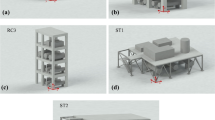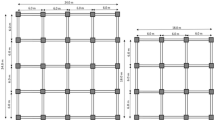Abstract
In the past few years, the construction of multi-storey timber buildings has increased significantly in locations where high-intensity ground motions are likely to occur. On the other hand, the fast development of wood engineered products, as glued-laminated timber (GLT) and cross-laminated timber (CLT), has been challenging researchers to provide adequate guidelines for the design and assessment of structures built in seismic regions. Some guidelines and analysis methods considered in seismic design can improve robustness, commonly described as the ability of structures to sustain limited damage without disproportionate effects. This paper proposes a probabilistic methodology for seismic and robustness assessment of timber-framed structures. The seismic performance and the progressive collapse potential of a three-storey building are here exemplified through the proposed methodology, which accounts for uncertainties in mechanical properties of members and connections, as well as for external loads. The Latin Hypercube Sampling (LHS) was used in each assessment to generate a set of 1000 structural models. Each structural model corresponds to a realization of the random variables used to define the structural model. Incremental dynamic analyses were performed to develop seismic fragility curves for different damage levels. The fragility functions for robustness assessment were developed for distinct damage scenarios, exploiting the results of an alternate load path analysis (ALPA) that involved the performance of nonlinear static analyses (pushdown analyses). The methodology presented is suitable for risk-based assessments that consider the occurrence of different exposures, such as earthquakes, impacts, and explosions, while considering the direct and indirect consequences of failures. However, the methodology involves time-consuming analyses with distinct load scenarios, which can constitute a burdening task within a typical building design phase.
Access this chapter
Tax calculation will be finalised at checkout
Purchases are for personal use only
Similar content being viewed by others
References
CEN. (2013). EN 1998–1: Eurocode 8: Design of structures for earthquake resistance Part 1: General rules, seismic actions and rules for buildings. European Committee for Standardisation.
Branco, J. M., & Neves, L. A. (2011). Robustness of timber structures in seismic areas. Engineering Structures, 33(11), 3099–3105.
Huber, J. A., Ekevad, M., Girhammar, U. A., & Berg, S. (2019). Structural robustness and timber buildings—A review. Wood Material Science & Engineering, 14(2), 107–128.
Melchers, R. E., & Beck, A. T. (2018). Structural reliability analysis and prediction. Wiley.
Köhler, J., Sørensen, J. D., & Faber, M. H. (2007). Probabilistic modelling of timber structures. Structural Safety, 29(4), 255–267.
Casagrande, D., Bezzi, S., D’Arenzo, G., Schwendner, S., Polastri, A., Seim, W., & Piazza, M. (2020). A methodology to determine the seismic low-cycle fatigue strength of timber connections. Construction and Building Materials, 231, 117026.
Vamvatsikos, D., & Fragiadakis, M. (2010). Incremental dynamic analysis for estimating seismic performance sensitivity and uncertainty. Earthquake Engineering & Structural Dynamics, 39(2), 141–163.
Starossek, U., & Haberland, M. (2010). Disproportionate collapse: Terminology and procedures. Journal of Performance of Constructed Facilities, 24(6), 519–528.
Ellingwood, B. R., Smilowitz, R., Dusenberry, D. O., Duthinh, D., Lew, H. S., & Carino, N. J. (2007). Best practices for reducing the potential for progressive collapse in buildings.
Alam, M. S., & Barbosa, A. R. (2018). Probabilistic seismic demand assessment accounting for finite element model class uncertainty: Application to a code-designed URM infilled reinforced concrete frame building. Earthquake Engineering & Structural Dynamics, 47(15), 2901–2920.
Callegari, E. (2009). Caratterizzazione del comportamento di telai sismoresistenti in legno lamellare, MS thesis (in Italian). Trento, Italy: Universita degli Studi di Trento.
CEN. (2004a). EN 1995-1-1:2004—Eurocode 5: Design of timber structures—Part 1-1: General—Common rules and rules for buildings (Vol. 1).
Rodrigues, L. G., Branco, J. M., Neves, L. A., & Barbosa, A. R. (2018). Seismic assessment of a heavy-timber frame structure with ring-doweled moment-resisting connections. Bulletin of Earthquake Engineering, 16(3), 1341–1371.
Rodrigues, L. G. (2019). Robustness of multi-storey timber buildings in seismic regions, Ph.D. thesis, University of Minho, Guimarães, Portugal.
. (2004b), EN 10025-2:2004, European standard for hot-rolled structural steel. Part 2—Technical delivery conditions for non-alloy structural steels.
CEN. (2005a), EN 14080 Timber structures—Glued laminated timber Requirements. European Committee for Standardisation.
Blass, H. J., & Fellmoser, P. (2004). Design of solid wood panels with cross layers. In Proceedings of the 8th World Conference on Timber Engineering 2014, 14–17 June, Lahti, Finland.
McKenna, F. (2011). OpenSees: A framework for earthquake engineering simulation. Computing in Science & Engineering, 13(4), 58–66.
Polastri, A., Tomasi, R., Piazza, M., & Smith, I. (2013). Moment resisting dowelled joints in timber structures: Mechanical behaviour under cyclic tests. Ingegneria Sismica, 30(4), 72–81.
United States Department of Defense. (2016). UFC 4-023-0.3. Design of buildings to resist progressive collapse.
CEN. (2006). EN 1991-1-7 (2006) Actions on structures. Part 1-7: General actions—Accidental actions. European Committee for Standardisation.
ARUP. (2011). Review of international research on structural robustness and disproportionate collapse (Tech. Rep.), London.
Acknowledgments
This work was partly financed by FEDER funds through the Competitiveness and Internationalization Operational Programme COMPETE, Portugal 2020, and by national funds through FCT—Foundation for Science and Technology within the Timquake project POCI-01-0145-FEDER-032031, and PhD grant PD/BD/113679/2015 included in the InfraRisk-PhD program.
Author information
Authors and Affiliations
Editor information
Editors and Affiliations
Rights and permissions
Copyright information
© 2021 The Author(s), under exclusive license to Springer Nature Switzerland AG
About this paper
Cite this paper
Rodrigues, L.G., Branco, J.M., Neves, L.A.C., Barbosa, A.R. (2021). Application of Fragility Analysis to Timber-Framed Structures for Seismic and Robustness Assessments. In: Matos, J.C., et al. 18th International Probabilistic Workshop. IPW 2021. Lecture Notes in Civil Engineering, vol 153. Springer, Cham. https://doi.org/10.1007/978-3-030-73616-3_12
Download citation
DOI: https://doi.org/10.1007/978-3-030-73616-3_12
Published:
Publisher Name: Springer, Cham
Print ISBN: 978-3-030-73615-6
Online ISBN: 978-3-030-73616-3
eBook Packages: EngineeringEngineering (R0)




